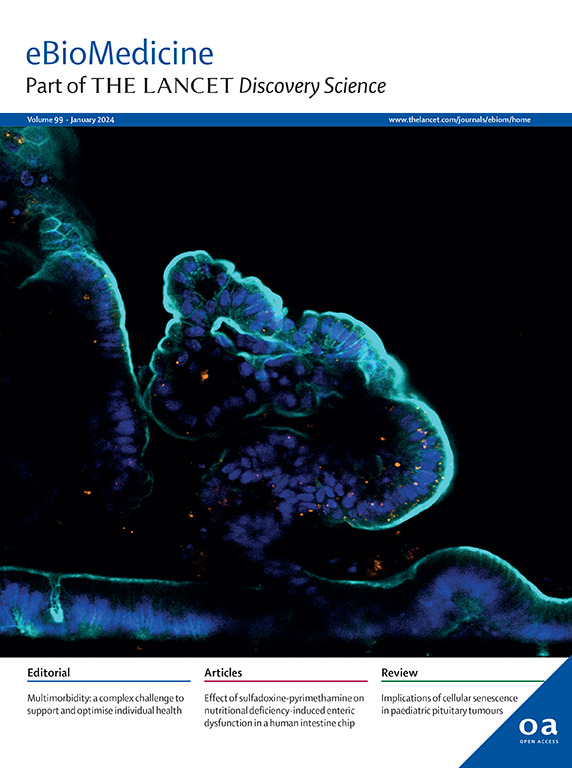Decoding the origins, spread, and global risks of mcr-9 gene.
IF 9.7
1区 医学
Q1 MEDICINE, RESEARCH & EXPERIMENTAL
引用次数: 0
Abstract
BACKGROUND The global spread of the plasmid-mediated mcr (mobilized colistin resistance) gene family presents a significant threat to the efficacy of colistin, a last-line defense against numerous Gram-negative pathogens. The mcr-9 is the second most prevalent variant after mcr-1. METHODS A dataset of 698 mcr-9-positive isolates from 44 countries is compiled. The historical trajectory of the mcr-9 gene is reconstructed using Bayesian analysis. The effective reproduction number is used innovatively to study the transmission dynamics of this mobile-drug-resistant gene. FINDINGS Our investigation traces the origins of mcr-9 back to the 1960s, revealing a subsequent expansion from Western Europe to the America and East Asia in the late 20th century. Currently, its transmissibility remains high in Western Europe. Intriguingly, mcr-9 likely emerged from human-associated Salmonella and exhibits a unique propensity for transmission within the Enterobacter. Our research provides a new perspective that this host preference may be driven by codon usage biases in plasmids. Specifically, mcr-9-carrying plasmids prefer the nucleotide C over T compared to mcr-1-carrying plasmids among synonymous codons. The same bias is seen in Enterobacter compared to Escherichia (respectively as their most dominant genus). Furthermore, we uncovered fascinating patterns of coexistence between different mcr-9 subtypes and other resistance genes. Characterized by its low colistin resistance, mcr-9 has used this seemingly benign feature to silently circumnavigate the globe, evading conventional detection methods. However, colistin-resistant Enterobacter strains with high mcr-9 expression have emerged clinically, implying a strong risk of mcr-9 evolving into a global "true-resistance-gene". INTERPRETATION This study explores the mcr-9 gene, emphasizing its origin, adaptability, and dissemination potential. Given the high mcr-9 expression colistin-resistant strains was observed in clinically the prevalence of mcr-9 poses a significant challenge to drug resistance prevention and control within the One Health framework. FUNDING This work was partially supported by the National Natural Science Foundation of China (Grant No. 32141001 and 81991533).解码 mcr-9 基因的起源、传播和全球风险。
背景质粒介导的 mcr(动员型可乐定耐药性)基因家族在全球范围内的传播对可乐定的疗效构成了严重威胁,而可乐定是抗击多种革兰氏阴性病原体的最后一道防线。本研究汇编了来自 44 个国家的 698 个 mcr-9 阳性分离物数据集。采用贝叶斯分析法重建了 mcr-9 基因的历史轨迹。我们的调查将 mcr-9 的起源追溯到了 20 世纪 60 年代,发现它随后在 20 世纪末从西欧扩展到了美洲和东亚。目前,其在西欧的传播率仍然很高。耐人寻味的是,mcr-9 很可能来自与人类相关的沙门氏菌,并在肠杆菌中表现出独特的传播倾向。我们的研究提供了一个新的视角,即这种宿主偏好可能是由质粒中密码子使用偏差驱动的。具体来说,在同义密码子中,与携带 mcr-1 的质粒相比,携带 mcr-9 的质粒更倾向于核苷酸 C 而不是 T。与埃希氏菌(分别是其最主要的属种)相比,肠杆菌也有同样的偏好。此外,我们还发现了不同 mcr-9 亚型与其他抗性基因共存的奇妙模式。mcr-9 的特点是对秋水仙碱的耐药性较低,它利用这一看似无害的特点悄无声息地环游世界,躲避传统的检测方法。然而,临床上出现了高表达 mcr-9 的耐秋水仙碱肠杆菌菌株,这意味着 mcr-9 极有可能演变为全球性的 "真正耐药基因"。鉴于临床上观察到的高表达 mcr-9 的耐秋水仙素菌株,mcr-9 的流行对 "一个健康 "框架下的耐药性预防和控制构成了重大挑战。
本文章由计算机程序翻译,如有差异,请以英文原文为准。
求助全文
约1分钟内获得全文
求助全文
来源期刊

EBioMedicine
Biochemistry, Genetics and Molecular Biology-General Biochemistry,Genetics and Molecular Biology
CiteScore
17.70
自引率
0.90%
发文量
579
审稿时长
5 weeks
期刊介绍:
eBioMedicine is a comprehensive biomedical research journal that covers a wide range of studies that are relevant to human health. Our focus is on original research that explores the fundamental factors influencing human health and disease, including the discovery of new therapeutic targets and treatments, the identification of biomarkers and diagnostic tools, and the investigation and modification of disease pathways and mechanisms. We welcome studies from any biomedical discipline that contribute to our understanding of disease and aim to improve human health.
文献相关原料
| 公司名称 | 产品信息 | 采购帮参考价格 |
|---|
 求助内容:
求助内容: 应助结果提醒方式:
应助结果提醒方式:


